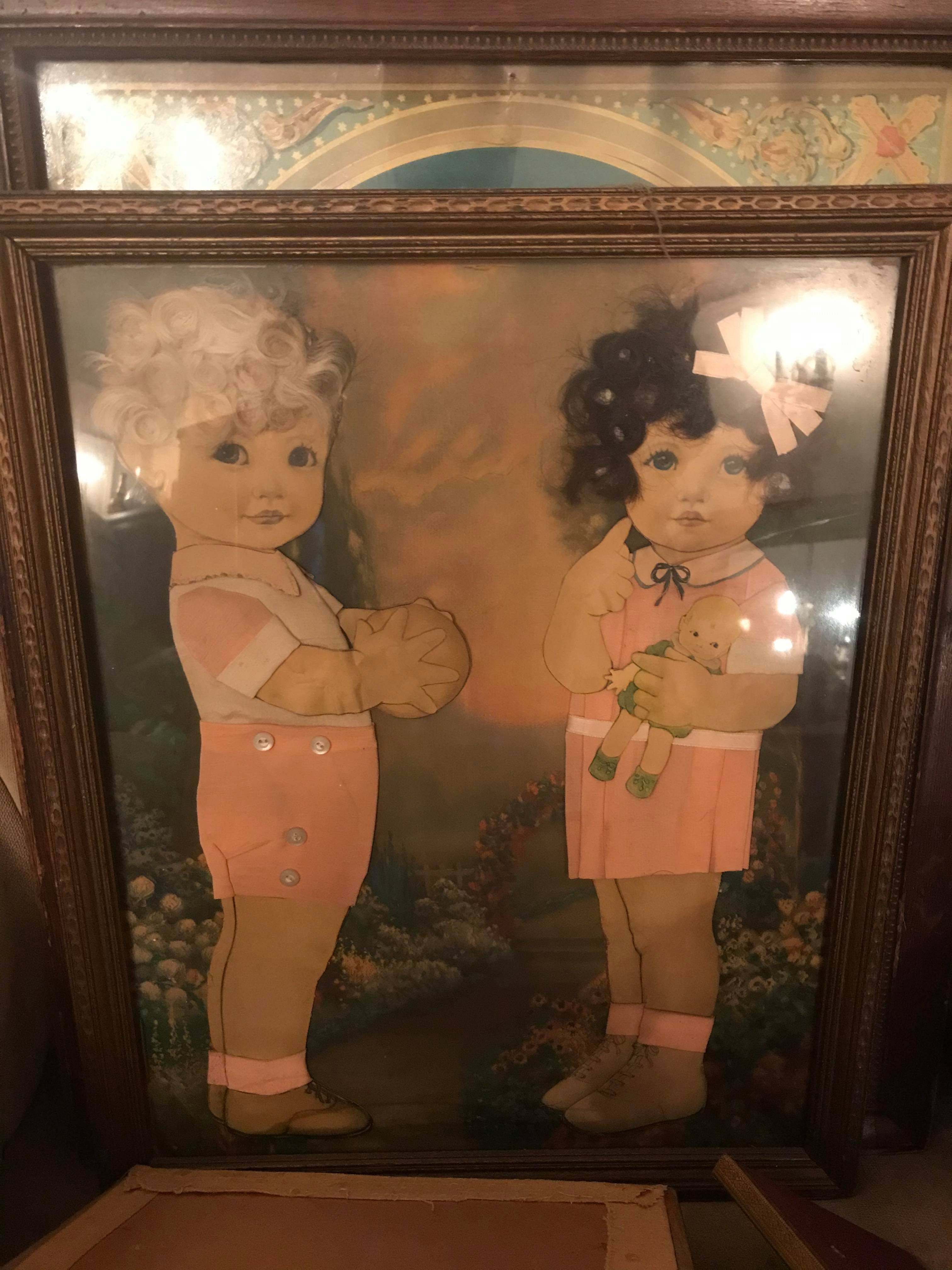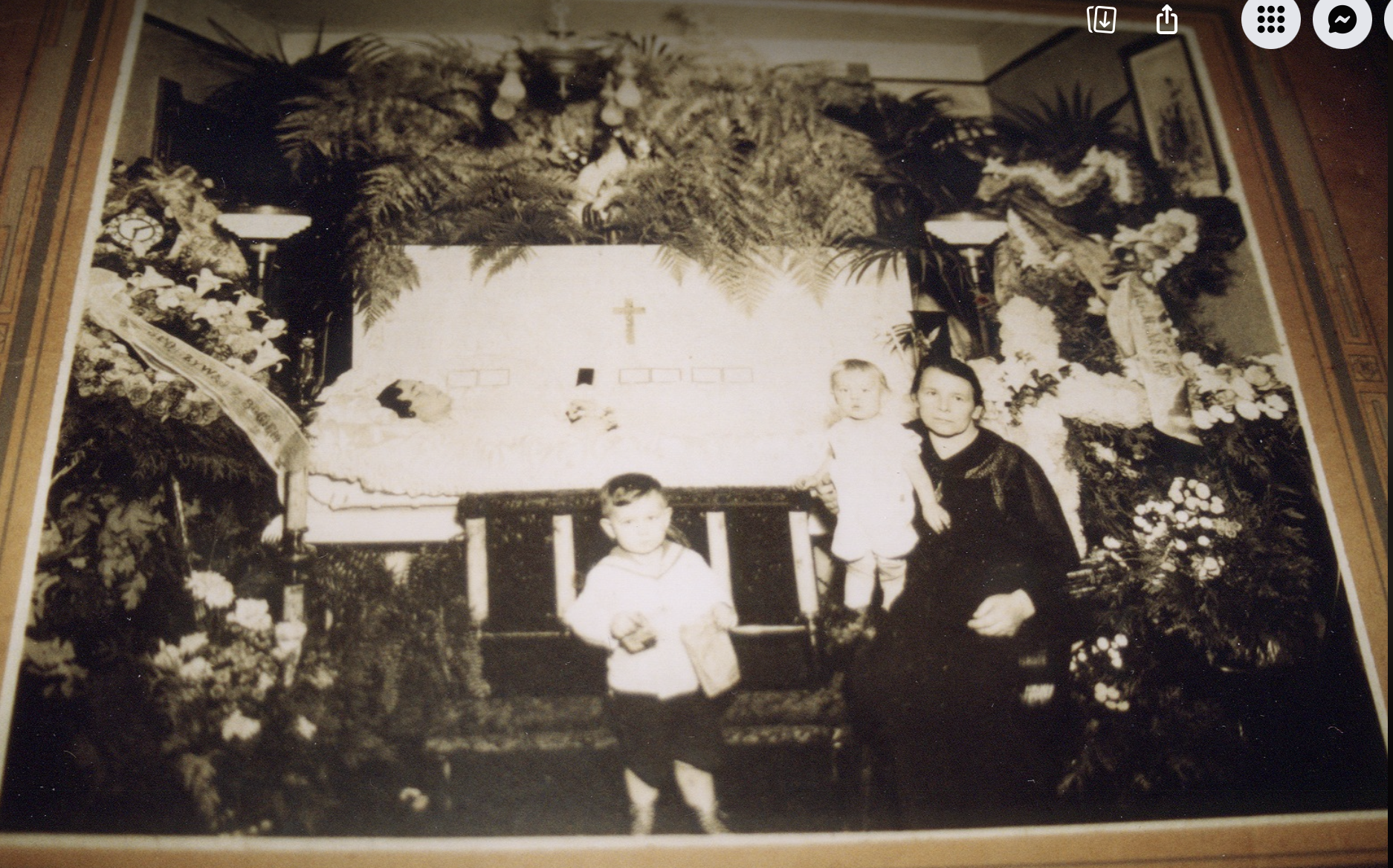HAIR, DOLLS, AND MARIANNA
by Anna Muller
(based on a story shared by Karen Majewski)

An image
The image portrays two dolls, or perhaps two doll-like children: a boy and a girl dressed in pink and white attire. The boy sports pink shorts paired with a white shirt accented by pink details, while the girl wears a pink dress with a white collar adorned with a black ribbon. The boy is blond, while the girl is a brunette. She has a pink bow in her hair. They stand facing each other, each holding a toy (a ball and a doll) and gazing straight ahead. These images were mass-produced, yet they served as canvases for creative embellishments. The pink clothing, bows, ribbons, and even buttons came from the clothing of real children and were meticulously arranged by the hands of someone breathing life into the initial image. But the most striking element of this composition is the real hair affixed to the image. Carefully arranged, these locks of hair once belonged to two small boys named John and Joe. This image, presented in an elegant wooden frame, is a cherished heirloom in Karen Majewski’s family. Crafted by her grandmother, Marianna Dudziak Majewski, in the early 1930s, it stands as a testament to motherly love, family memory, and perhaps the innate human need to create and craft even amid the daily hustle and bustle of life.
Family
The history of this image harks back to a time when Karen’s grandmother was a young mother of two. Born in Chicago in 1914, Marianna was taken back to Poland by her mother, where she was raised in Dubiecko, a town located between Rzeszów and Przemyśl. She returned to the United States in 1928 as a teenager. She got married in 1933. Her first son, John, was born the same year (1933). Her second son, Joe, was born in 1935. She died a year later, in 1936, at the age of twenty-three, leaving behind two small children. There is not much more information or even keepsakes related to her.
Karen, Marianna’s granddaughter, became visibly emotional when she recalled how she reconnected with her Polish heritage and the family of her grandmother, whom she never had a chance to meet. Karen is well-known in the Michigan Polish American community. As the first woman and a long-term beloved mayor of Hamtramck, Michigan, Karen is also highly respected in the Polish American academic community. In her book Traitors and True Poles: Narrating a Polish-American Identity, 1880–1939 (2003), she demonstrates how Polish American immigrant writers, while passionately engaging with national identity, reveal a transnational ethnic identity that is both tied to and independent of Poland.
Nowadays, one can often find Karen wandering the streets of Hamtramck, still concerned with the well-being of the city she loves. She can also be found at Oloman Café, run by a friendly Bosnian named Zlatan, or at her store, Tekla Vintage, a vintage clothing store filled with a trove of unique, random, and beautiful pieces of clothing. Tekla is more than just a second-hand clothing store; it reflects Karen’s passion, curiosity, and aptitude for careful observation, which helps her engage with the world’s secrets through seemingly unwanted and forgotten objects. These objects, often worn, touched, and sometimes carrying a foreign smell, still communicate love, beauty, social norms, and ways of challenging them. They communicate with her, perhaps similarly to the way her grandmother appears closer to her thanks to the image – mass-produced, yet unique. It shows her respect for the past, heritage, artistry, and craft.
Hair
The image of a doll-like boy and girl carries the real hair of Marianna’s children, John and Joe. As I delved into the significance of hair, I discovered that one prevalent cultural belief of the early 1900s was that hair could connect people, even those separated by death. Hair often carries layers of symbolism that touch on the boundaries between life and death, and, therefore, it is intertwined with notions of vitality, strength, and even spiritual importance. A well-known tradition involves preserving locks of hair and fashioning them into necklaces, lockets, and brooches. In Polish culture, there is, for example, the practice of postrzyżyny, a ritual of cutting the hair of younger boys celebrating a moment of transition, a letting go, or a fresh start – a metaphorical bridge to new chapters of life. Hair’s proximity to the scalp, where thoughts and consciousness reside, gives it a bridge-like quality that connects the realms of the living and the intangible beyond. Finally, as cited by historian Tiya Miles in All That She Carried: The Journey of Ashley’s Sack, A Black Family Keepsake (2021), fiber artist Sonia Clark eloquently stated, “A carrier of DNA, hair is the essence of identity. Deep within each strand, the vestiges of our roots and histories resound” (p. 116).
Ties to Poland
In my conversation with her, Karen mentioned that this particular object could belong to anyone, and there is nothing inherently Polish about it, except that it serves as a bridge to her Polish American identity. For Karen, the journey across that bridge began in the early 1980s. After the passing of her father, she decided to reach out to his family in Poland. She found a letter her father had received some time ago from Poland, which was written in dense and illegible Polish cursive. Although she could not read it, she cut and pasted the address on an envelope and sent a letter to this address in Poland explaining who she was. At the time, she had no idea who she was reaching out to, except that it was some distant Polish family. That initial letter marked a turning point in Karen’s life: it led to a journey to Poland and later multiple trips and conversations with newfound family members. That letter helped to recover links that appeared to be long lost to the language, the family, the culture, and perhaps even to some familiar traits, such as a love for dancing, that apparently Karen and her grandmother both shared.

On the photo, Karen Majewski’s grandmother Marianna in her coffin back when funerals were held at home. Next to the coffin is Aniela, Marianna's mother and her two sons. Karen was told that John, her father, saw the spirit of his mother in the corner at the ceiling that day.